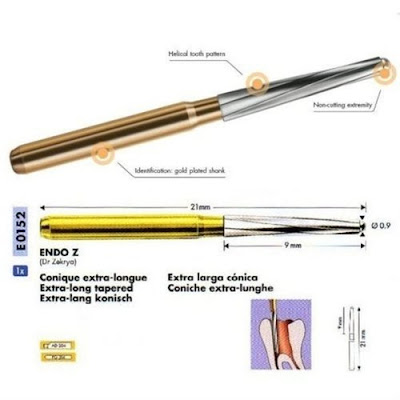Endo Z bur
Today I tried an Endo Z bur to open the access cavity for an upper molar. I've used one before but not the way it was intended and not very successfully. The Endo Z bur is a bur specifically designed for the endo access, the bur has tungsten carbide cutting flutes and a non cutting tip (Figure 1)
 |
| Figure 1: Endo Z bur design |
The bur is designed to be inserted into a cavity once the pulp chamber has been opened and moved around to widen the access (Figure 2). The non cutting tip is supposed to be held against the floor of the pulp chamber and when the wall of the chamber is encountered the bur will theoretically stop cutting. It is supposed to make the process of cutting the access foolproof. Note: This is only relevant in multi rooted teeth. It can still be used in single canaled teeth but shouldn't be used with any apical pressure.
My experience today was that the bur I used cut fairly slowly so I was putting a lot of pressure to cut the access. I would probably be more careful in the future not to put too much pressure and just let the bur do the work. I was also under the impression that I just had to put the bur in and move it around but I wasn't particularly paying much attention to the angulation of the bur so I ended up cutting too much off the palatal aspect ( Figure 2d). In the future, I will be careful to hold the bur parallel to the long axis of the tooth. The tapered nature of the bur will produce an access that is tapered ideally. If you want to have a very conservative, narrow access then the Endo Z bur used in this way may not be the best approach. Instead, a parallel sided diamond bur or an Endo Z bur used at an angle tilted inwards towards the centre of the access cavity can produce a narrower prep.

Hey mate.
ReplyDeleteI stumbled across your blog today and I just wanted to say what a great initiative this is. Based on my reading, my career has followed a very similar journey including a mix of public, private and teaching/mentoring.
I appreciate the time you take to write this all out. Especially with the introspective way you approach our profession. It certainly urges me to reflect on the way I practice.
Please keep up the great work!